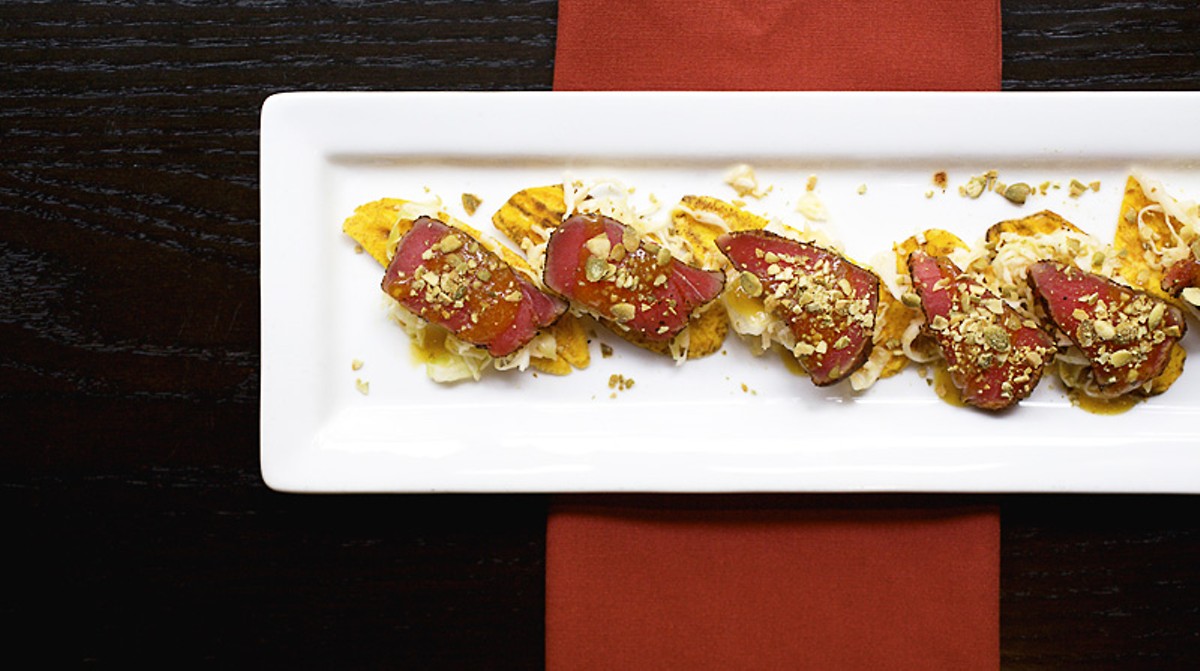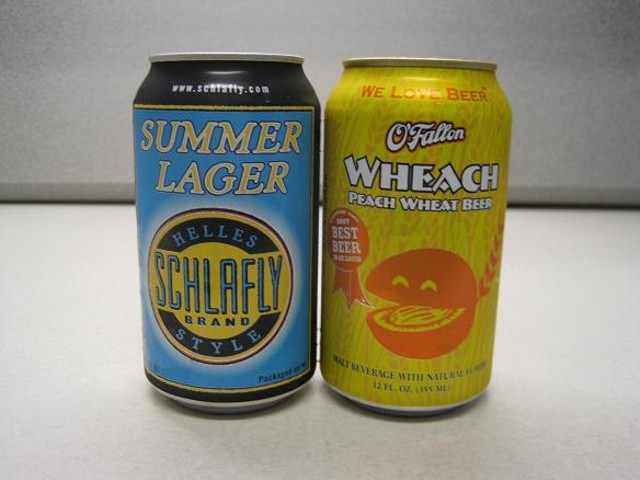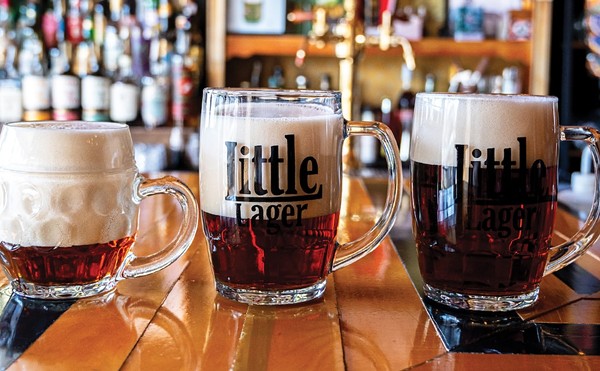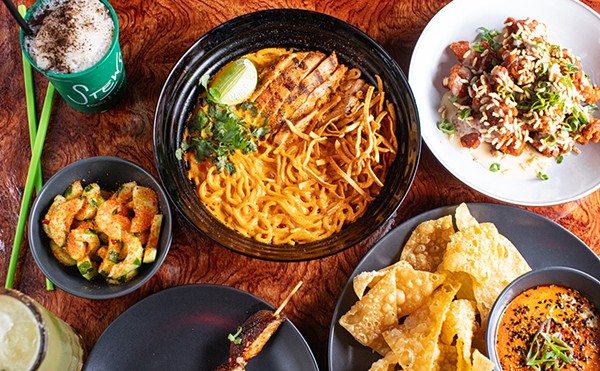The show must go on at Grand Center, where restaurants continue to open, even with the specters of failures past hovering like ghosts of tragic heroes over the city's wanna-be entertainment destination. The newest player strutting across the stage is Kota Wood Fire Grill, which opened in February in Grand Center's most vexing address, directly across North Grand Boulevard from the Fox Theatre marquee. You might remember this location as the site of the spectacular flameout of the Tuxedo Room, whose splashy late-2006 debut was followed three months later by an acrimonious self-immolation. Reggie's Backstage, the Tux's longer-lived successor, died with a whimper rather than a bang — still, it died.
Both the Tuxedo Room and Reggie's Backstage made the obvious pitch to theatergoers. Obvious, but flawed. Yes, patrons of the Fox, Sheldon and Grand Center's other venues might want to eat before or after a show, but the strategy doesn't account for nights when some or all of the venues are dark, not to mention those of us who would rather have hot pokers shoved under our fingernails than sit through Wicked or Billy Elliot the Musical.
And then there's the complication of parking in Grand Center — recently made infinitely more frustrating for theatergoers and diners alike with the extension of meter hours to 10 p.m. and the limiting of time at the meters to 90 minutes. On one visit to Kota, I maxed out my meter and still had to duck out halfway through my main course to feed the damn thing. (Kota does validate valet parking, which reduces the fee from $10 to $5, not including tip.)
Smartly, Kota's menu and overall aesthetic are crafted to appeal to a broad (which is not to say generic) audience rather than strictly a theatergoing one. The décor ditches the Broadway kitsch of previous inhabitants for a clean, colorful design that mostly relies on the view from the windows onto Grand Center. There's even a playful sense at work: The menu features milkshakes laced with liquor. (Regular milkshakes are also available for the kids or the dessert-inclined.)
This isn't surprising, considering that Kota shares owner Steve Smith and consultant Chris LaRocca of Culinarchgroup (formerly known as Culinary Architects) with the successful nearby restaurant Triumph Grill. Granted, when I reviewed Triumph Grill in January 2009, I found its menu too scattershot, drawn seemingly at random from the cuisines of Asia, India, the American Southwest and elsewhere. To Kota, however, chef Jason Tilford brings a much sharper focus, drawing flavors primarily from the Caribbean and the Gulf Coast. As you might expect with such a profile, seafood dishes predominate.
The "Miami Mahi," for example, is a medium-thick mahi-mahi fillet coated with crushed plantain chips, then pan-fried and drizzled with a key-lime vinaigrette. Not surprisingly, the plantain crust doesn't convey much flavor, but it keeps the mahi mahi tender, and the key-lime vinaigrette provides a welcome twist to the citric note you so often want with seafood. The side dishes — those served with the mahi mahi and in general — are satisfying if unimaginative: in this case, mildly spicy "Cuban-style" black beans and rice and a medley of grilled vegetables.
Plantains play the role of "tostada" in an ahi tuna appetizer, thin slices of tuna seared rare and set atop plantain chips, the tuna topped with a lime-spiked slaw, a mango-habanero sauce and toasted pepitas. The sauce isn't as peppery as a habanero sauce usually is, but this does allow the mango's sweetness to be more prominent, and the dish as a whole gives a little pizzazz to tried-and-true tuna.
"Garlic Barbecue Delta Shrimp," another appetizer, is a fancy name for shrimp and grits. The shrimp are served in a thick, garlicky, mocha-colored barbecue sauce — so full-flavored that you hardly notice how bland the shrimp are. (Of course, that's a hazard of cooking with shrimp.) Chipotle peppers and bits of fried sweet potato give the Gouda cheese-laden grits an extra depth of flavor — mostly the smoky note of chipotle, though not overwhelmingly so.
Among seafood dishes, only the "Big Bang Fish Tacos" are an outright disappointment. Grilled tilapia fillets and shredded cabbage are wrapped in flour tortillas and served with a weak fresh salsa and a too-mild cilantro-cream sauce. A general rule of thumb: A fish as inherently insipid as tilapia, no matter how you gussy it up with flavor, should never be billed with the phrase "Big Bang."
The standout among the non-seafood dishes is the smoked pork chop, an impressive bone-in specimen stuffed with an apple-fig chutney and topped with an ancho-maple sauce. I liked the interplay between the fruit's mild sweetness and the darker, richer spice of ancho chiles, and the chop itself was tender, its natural flavor imbued with a touch of hickory smoke. This is served with aforementioned grits and the (also aforementioned) vegetable medley.
Beef tenderloin is billed as "espresso-rubbed," but the meat comes doused in a blue-cheese sauce that swamps any flavor of coffee — and much of the natural flavor of beef besides. The pan-fried chicken breast, on the other hand, could use an extra kick of flavor. The exterior of the chicken is crisp but lacks much seasoning.
The chicken, too, is served with those chipotle-Gouda grits. The kitchen is awfully proud of those grits, it seems. And they are good — but they are also symptomatic of what holds Kota back from being anything more than a pleasant but unmemorable restaurant. The better dishes dabble in strong flavors without committing. The habanero isn't fiery; the chipotle doesn't smolder; the espresso barely percolates.
Here, again, is the drawback to opening in Grand Center: You have a captive audience, and you don't want to alienate the majority of them, so you calibrate even your strongest flavors at safe levels. What, then, will draw diners back on those nights when the Fox is dark, the Sheldon silent and the only excitement belongs to the meter-enforcement officer, who's certain that given the choice of ordering dessert or pumping in a few quarters and then ordering dessert, you'll choose dessert?






